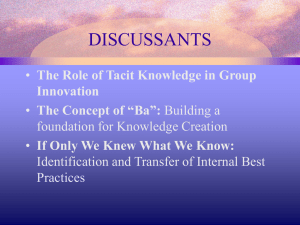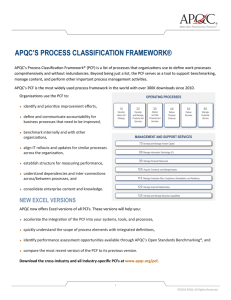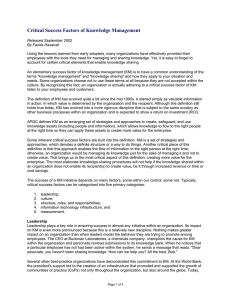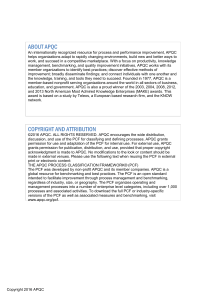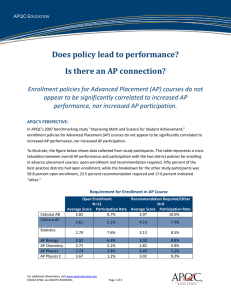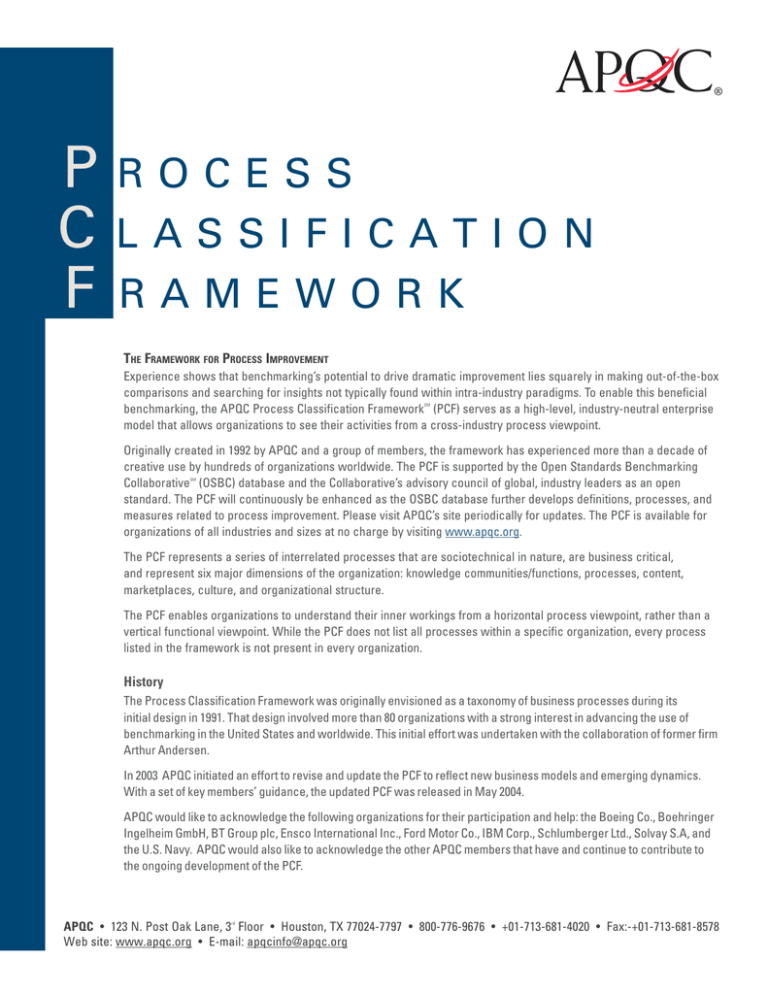
APOC
P
C
F
®
ROCESS
LASSIFICATION
RAMEWORK
THE FRAMEWORK FOR PROCESS IMPROVEMENT
Experience shows that benchmarking’s potential to drive dramatic improvement lies squarely in making out-of-the-box
comparisons and searching for insights not typically found within intra-industry paradigms. To enable this beneficial
benchmarking, the APQC Process Classification Framework (PCF) serves as a high-level, industry-neutral enterprise
model that allows organizations to see their activities from a cross-industry process viewpoint.
SM
Originally created in 1992 by APQC and a group of members, the framework has experienced more than a decade of
creative use by hundreds of organizations worldwide. The PCF is supported by the Open Standards Benchmarking
Collaborative (OSBC) database and the Collaborative’s advisory council of global, industry leaders as an open
standard. The PCF will continuously be enhanced as the OSBC database further develops definitions, processes, and
measures related to process improvement. Please visit APQC’s site periodically for updates. The PCF is available for
organizations of all industries and sizes at no charge by visiting www.apqc.org.
SM
The PCF represents a series of interrelated processes that are sociotechnical in nature, are business critical,
and represent six major dimensions of the organization: knowledge communities/functions, processes, content,
marketplaces, culture, and organizational structure.
The PCF enables organizations to understand their inner workings from a horizontal process viewpoint, rather than a
vertical functional viewpoint. While the PCF does not list all processes within a specific organization, every process
listed in the framework is not present in every organization.
History
The Process Classification Framework was originally envisioned as a taxonomy of business processes during its
initial design in 1991. That design involved more than 80 organizations with a strong interest in advancing the use of
benchmarking in the United States and worldwide. This initial effort was undertaken with the collaboration of former firm
Arthur Andersen.
In 2003 APQC initiated an effort to revise and update the PCF to reflect new business models and emerging dynamics.
With a set of key members’ guidance, the updated PCF was released in May 2004.
APQC would like to acknowledge the following organizations for their participation and help: the Boeing Co., Boehringer
Ingelheim GmbH, BT Group plc, Ensco International Inc., Ford Motor Co., IBM Corp., Schlumberger Ltd., Solvay S.A, and
the U.S. Navy. APQC would also like to acknowledge the other APQC members that have and continue to contribute to
the ongoing development of the PCF.
rd
APQC • 123 N. Post Oak Lane, 3 Floor • Houston, TX 77024-7797 • 800-776-9676 • +01-713-681-4020 • Fax:-+01-713-681-8578
Web site: www.apqc.org • E-mail: apqcinfo@apqc.org
Process Classification Framework
Table of Contents
Interpreting the PCF .................................................................................................................................................................................. 2
Overview ..................................................................................................................................................................................................... 3
1.0 Develop Vision and Strategy ..................................................................................................................................................... 4
2.0 Design and Develop Products and Services ......................................................................................................................... 4
3.0 Market and Sell Products and Services ................................................................................................................................. 5
4.0 Deliver Products and Services ................................................................................................................................................. 5
5.0 Manage Customer Service........................................................................................................................................................ 6
6.0 Develop and Manage Human Capital...................................................................................................................................... 6
7.0 Manage Information Technology and Knowledge ................................................................................................................ 8
8.0 Manage Financial Resources ................................................................................................................................................... 9
9.0 Acquire, Construct, and Manage Property .......................................................................................................................... 10
10.0 Manage Environmental Health and Safety........................................................................................................................... 11
11.0 Manage External Relationships.............................................................................................................................................. 11
12.0 Manage Improvement and Change ....................................................................................................................................... 11
Interpreting the PCF
Category: The highest level within the PCF indicated by whole numbers (e.g., 8.0 and 9.0).
Process Groups: All PCF items with one decimal numbering (e.g., 8.1 and 9.1) are considered a process area.
Process: All PCF items with two decimal numbering (e.g., 8.1.1 and 9.1.2) are considered processes.
Activity: Items with three decimals (e.g., 8.3.1.1 and 9.1.1.1) are considered activities within a process.
Example:
Deliver Products and Services (Category) (4.0)
Plan for and acquire necessary resources—supply chain planning (Process Group) (4.1)
Manage demand for products and services (Process) (4.1.1)
Develop baseline forecasts (Activity) (4.1.1.1)
Collaborate with customers (Activity) (4.1.1.2)
Develop performance management structures and procedures (Task) (6.3.2.1.1)
2
Permission granted to photocopy for personal use. ©2004 APQC
Process Classification Framework
Overview
/0%2!4).'02/#%33%3
$EVELOP6ISIONAND3TRATEGY
$ESIGNAND$EVELOP0RODUCTSAND3ERVICES
-ARKETAND3ELL0RODUCTSAND3ERVICES
$ELIVER0RODUCTSAND3ERVICES
-ANAGE#USTOMER3ERVICE
-!.!'%-%.4!.$3500/2402/#%33%3
Permission granted to photocopy for personal use. ©2004 APQC
$EVELOPAND-ANAGE(UMAN#APITAL
-ANAGE)NFORMATION4ECHNOLOGYAND+NOWLEDGE
-ANAGE&INANCIAL2ESOURCES
!CQUIRE#ONSTRUCTAND-ANAGE0ROPERTY
-ANAGE%NVIRONMENTAL(EALTHAND3AFETY
-ANAGE%XTERNAL2ELATIONSHIPS
-ANAGE)MPROVEMENTAND#HANGE
3
Process Classification Framework
1.0 Develop Vision and Strategy
1.1 Define the business concept and long-term vision
1.1.1 Assess the external environment
1.1.1.1 Analyze and understand competition
1.1.1.2 Identify economic trends
1.1.1.3 Identify political and regulatory issues
1.1.1.4 Assess new technology innovations
1.1.1.5 Understand demographics
1.1.1.6 Identify social and cultural changes
1.1.1.7 Understand ecological concerns
1.1.2 Survey market and determine customer needs and
wants
1.1.2.1 Conduct qualitative/quantitative assessments
1.1.2.2 Capture and assess customer needs
1.1.3 Select relevant markets
1.1.4 Perform internal analysis
1.1.4.1 Analyze organizational characteristics
1.1.4.2 Baseline current processes
1.1.4.3 Analyze systems and technology
1.1.4.4 Analyze financial positions
1.1.4.5 Identify enterprise core competencies
1.1.5 Establish strategic vision
1.1.5.1 Align stakeholders around strategic vision
1.2 Develop business strategy
1.2.1 Develop overall mission statement
1.2.2 Evaluate strategic options
1.2.3 Develop and manage merger/acquisition/
divestiture strategy
1.2.4 Develop enterprise-level brand strategy
1.2.5 Develop a knowledge management strategy
1.2.5.1 Identify knowledge management needs in all
core functions
1.2.5.2 Develop a business case for managing
knowledge in core functions
1.2.5.3 Identify corporate and business unit
responsibilities for knowledge management
activities
1.2.6 Design the organizational structure and relationships
between organizational units
1.2.7 Develop and set organizational goals
1.2.8 Formulate business unit strategy
1.3 Manage strategic initiatives
1.3.1 Develop strategic initiatives
1.3.2 Evaluate strategic initiatives
1.3.3 Select strategic initiatives
1.3.4 Establish high-level measures
2.0 Design and Develop Products and Services
2.1 Design products and services
2.1.1 Develop strategy and concepts for new products and
services
2.1.1.1 Research customer and market needs
2.1.1.2 Plan and develop cost and quality targets
2.1.1.3 Develop product life cycle and development
timing targets
4
2.1.1.4
2.1.2
2.1.3
2.1.4
2.1.5
2.1.6
2.1.7
Research leading technology, components,
and development requirements
2.1.1.5 Integrate leading technology into product/
service concept and components
Generate new products and services, and evaluate and
refine existing products and services
2.1.2.1 Translate customer wants and needs into
product/service ideas
2.1.2.2 Generate new product/service ideas
2.1.2.3 Evaluate existing products based on NPD
strategy
2.1.2.4 Identify enhancements/extensions to existing
product and services
2.1.2.5 Define product and service functionality
2.1.2.6 Retire outdated products/services
2.1.2.7 Identify and refine performance indicators
Design, build, and evaluate products and services
2.1.3.1 Assign resources to product/service project
2.1.3.2 Prepare high-level business case and
technical assessment
2.1.3.3 Develop product/service design
specifications
2.1.3.4 Document design specifications
2.1.3.5 Build prototypes
2.1.3.6 Eliminate quality and reliability problems
2.1.3.7 Conduct in-house product/service testing and
evaluate feasibility
2.1.3.8 Identify design/development performance
indicators
2.1.3.9 Collaborate design with suppliers and
contract manufacturers
Test market for new or revised products and services
2.1.4.1 Prepare detailed market study
2.1.4.2 Conduct customer tests and interviews
2.1.4.3 Finalize product/service characteristics and
business cases
2.1.4.4 Finalize technical requirements
2.1.4.5 Identify requirements for changes to
manufacturing/delivery processes
Prepare for production and marketplace introduction
2.1.5.1 Develop and test prototype production and/or
service delivery process
2.1.5.2 Design and obtain necessary materials and
equipment
2.1.5.3 Install and validate process or methodology
2.1.5.4 Introduce new product and/or service
commercially
Support product manufacturing and service delivery
Support design and implementation of changes to
manufacturing/delivery process
2.1.7.1 Monitor production runs
2.1.7.2 Identify product/service design and
configuration changes
2.1.7.3 Capture feedback to “refine existing products
and services” process
2.1.7.4 Identify manufacturing/service delivery
process performance indicators
Permission granted to photocopy for personal use. ©2004 APQC
Process Classification Framework
3.0 Market and Sell Products and Services
3.1 Develop marketing, distribution, and channel strategy
3.1.1 Understand consumer needs and predict customer
purchasing behavior
3.1.2 Identify market segments and target customers
3.1.3 Define offering and positioning
3.1.4 Define and manage channel strategy
3.2 Develop and manage customer strategy
3.2.1 Develop customer management strategies
3.2.2 Establish customer management goals
3.2.3 Develop sales forecast
3.2.4 Establish overall sales budgets
3.2.5 Establish customer management metrics
3.2.6 Prepare/Analyze/Evaluate customer management
results
3.3 Manage advertising, pricing, and promotional activities
3.3.1 Develop and manage advertising
3.3.1.1 Define advertising objectives and strategy
3.3.1.2 Define target audience
3.3.1.3 Engage third-party advertising agency
3.3.1.4 Develop advertising
3.3.2 Develop and manage communication
3.3.2.1 Develop media budget
3.3.2.2 Develop media plan
3.3.2.3 Execute media plan
3.3.3 Develop and manage placement and campaign
management
3.3.4 Develop and manage pricing
3.3.4.1 Develop volume/unit forecast and set price
3.3.4.2 Execute pricing plan
3.3.4.3 Evaluate pricing performance
3.3.4.4 Refine pricing as needed
3.3.5 Develop and manage promotional activities
3.3.5.1 Define direct-to-consumer promotional
concepts
3.3.5.2 Plan direct-to-consumer activities
3.3.5.3 Test and execute direct-to-consumer
promotional activities
3.3.5.4 Prepare/Analyze/Evaluate direct-toconsumer promotional performance metrics
3.3.5.5 Refine direct-to-consumer promotional
performance metrics
3.3.5.6 Define trade-to-consumer promotional
concepts
3.3.5.7 Plan trade-to-consumer activities
3.3.5.8 Test and execute trade-to-consumer
promotional activities
3.3.5.9 Prepare/Analyze/Evaluate trade-to-consumer
promotional performance metrics
3.3.5.10 Refine trade-to-consumer promotional
performance metrics
3.3.6 Develop and manage packaging strategy
3.3.6.1 Plan packaging strategy
3.3.6.2 Test packaging options
3.3.6.3 Execute packaging strategy
3.3.6.4 Refine packaging
Permission granted to photocopy for personal use. ©2004 APQC
3.4
3.5
3.6
Manage sales partners and alliances
Manage sales opportunities and sales pipeline
3.5.1 Identify and manage key customers and accounts
3.5.1.1 Develop key customer plans
3.5.1.2 Identify priority customers
3.5.1.3 Establish budgets
3.5.1.4 Develop sales/key account plan
3.5.1.5 Schedule calls to customers
3.5.1.6 Execute agreed to sales plan
3.5.1.7 Prepare/Analyze/Evaluate sales results
Enter, process, and track orders—order management
3.6.1 Accept and validate sales orders
3.6.2 Collect and maintain customer account information
3.6.3 Determine stock availability
3.6.4 Determine logistics and transportation
3.6.5 Enter orders into system
3.6.6 Process back orders and updates
3.6.7 Handle order inquiries including post-order fulfillment
transactions
4.0 Deliver Products and Services
4.1 Plan for and acquire necessary resources—supply chain
planning
4.1.1 Manage demand for products and services
4.1.1.1 Develop baseline forecasts
4.1.1.2 Collaborate with customers
4.1.1.3 Develop consensus forecast
4.1.1.4 Allocate available to promise
4.1.2 Create materials plan
4.1.2.1 Create unconstrained plan
4.1.2.2 Collaborate with supplier and contract
manufacturers
4.1.2.3 Identify critical materials and supplier
capacity
4.1.2.4 Generate constrained plan
4.1.3 Schedule production
4.1.3.1 Generate site level plan
4.1.3.2 Manage work-in-progress inventory
4.1.3.3 Collaborate with suppliers
4.1.3.4 Generate and execute detail schedule
4.2 Procure materials and services
4.2.1 Develop sourcing strategies
4.2.1.1 Develop procurement plan
4.2.1.2 Clarify purchasing requirements
4.2.1.3 Match needs to supply capabilities
4.2.1.4 Analyze company’s spend profile
4.2.1.5 Seek opportunities to improve efficiency and
value
4.2.2 Select suppliers and develop/maintain contracts
4.2.2.1 Identify suppliers
4.2.2.2 Certify and validate suppliers
4.2.2.3 Negotiate contracts
4.2.2.4 Manage contracts
4.2.3 Order materials and services
4.2.3.1 Process/Review requisitions
4.2.3.2 Approve requisitions
5
Process Classification Framework
4.3
4.4
4.5
6
4.2.3.3 Solicit/Track vendor quotes
4.2.3.4 Create/Distribute purchase orders
4.2.3.5 Expedite orders and satisfy inquiries
4.2.3.6 Record receipt of goods
4.2.3.7 Research/Resolve exceptions
4.2.4 Appraise and develop suppliers
4.2.4.1 Monitor/Manage supplier information
4.2.4.2 Prepare/Analyze spending and vendor
performance
4.2.4.3 Support inventory/production processes
Produce/Manufacture/Deliver product
4.3.1 Schedule production
4.3.2 Produce product
4.3.3 Schedule and perform maintenance
Deliver product/service to customer
4.4.1 Confirm specific service requirements for individual
customer
4.4.2 Identify and schedule resources to meet service
requirements
4.4.3 Provide the service to specific customers
4.4.4 Ensure quality of service
Manage logistics and warehousing
4.5.1 Define logistics strategy
4.5.1.1 Translate customer service requirements into
logistics requirements
4.5.1.2 Design logistics network
4.5.1.3 Communicate outsourcing needs
4.5.1.4 Develop and maintain delivery service policy
4.5.1.5 Optimize transportation schedules and costs
4.5.1.6 Define key performance measures
4.5.2 Plan inbound material flow
4.5.2.1 Plan inbound material receipts
4.5.2.2 Manage inbound material flow
4.5.2.3 Monitor inbound delivery performance
4.5.2.4 Manage flow of returned products
4.5.3 Operate warehousing
4.5.3.1 Track inventory deployment
4.5.3.2 Receive, inspect, and store inbound
deliveries
4.5.3.3 Track product availability
4.5.3.4 Pick, pack, and ship product for delivery
4.5.3.5 Track inventory accuracy
4.5.3.6 Track third-party logistics storage and
shipping performance
4.5.4 Operate outbound transportation
4.5.4.1 Plan, transport, and deliver outbound product
4.5.4.2 Track carrier delivery performance
4.5.4.3 Manage transportation fleet
4.5.4.4 Process and audit carrier invoices and
documents
4.5.5 Manage returns: manage reverse logistics
4.5.5.1 Authorize and process returns
4.5.5.2 Perform reverse logistics
4.5.5.3 Perform salvage activities
4.5.5.4 Manage and process warranty claims
5.0 Manage Customer Service
5.1 Develop customer care/customer service strategy
5.2 Develop and manage customer profiles
5.3 Manage customer service transactions
5.3.1 Perform customer support
5.3.2 Obtain after-sale feedback
5.3.3 Respond to customer inquiries
5.3.3.1 Respond to information requests
5.3.3.2 Respond to billing inquiries
5.3.3.3 Respond to service inquiries
5.3.4 Manage customer complaints
5.3.5 Capture and assess customer feedback
5.3.5.1 Conduct qualitative/quantitative assessments
5.3.6 Measure customer satisfaction
5.3.6.1 Monitor satisfaction with products and
services
5.3.6.2 Monitor satisfaction with complaint resolution
5.3.6.3 Monitor satisfaction with communication
5.3.6.4 Determine customer loyalty/lifetime value
5.4 Perform account management (i.e., service the relationship)
6.0 Develop and Manage Human Capital
6.1 Create and manage human resources (HR) planning, policy,
and strategies
6.1.1 Manage/Align/Deliver HR strategy
6.1.1.1 Identify organizational strategic HR needs
6.1.1.2 Identify organizational tactical HR needs
6.1.1.3 Define HR and business function roles and
accountability
6.1.1.4 Determine HR costs
6.1.2 Develop and implement HR plans
6.1.2.1 Develop work force plan
6.1.2.2 Develop compensation plan
6.1.2.3 Develop succession plan
6.1.2.4 Develop employee diversity plan
6.1.2.5 Develop other HR programs
6.1.2.6 Develop HR policies
6.1.2.7 Administer HR policies
6.1.2.8 Plan employee benefits
6.1.3 Monitor and update plans
6.1.3.1 Measure realization of objectives
6.1.3.2 Measure contribution to business strategy
6.1.3.3 Communicate plans and provide updates to
stakeholders
6.1.3.4 Determine value added from HR function
6.1.3.5 Review and revise HR plans
6.2 Recruit, source, and select employees
6.2.1 Create and develop employee requisitions
6.2.1.1 Develop and open job requisition
6.2.1.2 Develop a job description
6.2.1.3 Post requisition
6.2.1.4 Manage internal/external job posting Web
sites
6.2.1.5 Change/Update requisition
6.2.1.6 Notify hiring manager
6.2.1.7 Manage requisition date
Permission granted to photocopy for personal use. ©2004 APQC
Process Classification Framework
6.3
Recruit candidates
6.2.2.1 Determine recruitment methods
6.2.2.2 Perform recruiting activities/events
6.2.2.3 Manage recruitment vendors
6.2.3 Screen and select candidates
6.2.3.1 Identify and deploy candidate selection tools
6.2.3.2 Interview candidates
6.2.3.3 Test candidates
6.2.3.4 Select and reject candidates
6.2.4 Manage preplacement verification
6.2.4.1 Complete candidate background information
6.2.4.2 Conduct background checks
6.2.4.3 Recommend/Not recommend candidate
6.2.5 Manage new hire/rehire
6.2.5.1 Draw up and make offer
6.2.5.2 Negotiate offer
6.2.5.3 Hire candidate
6.2.6 Track candidates
6.2.6.1 Create applicant record
6.2.6.2 Manage/Track applicant data
6.2.6.3 Archive and retain records of non-hires
Develop and counsel employees
6.3.1 Manage employee orientation and deployment
6.3.1.1 Create/Maintain employee induction program
6.3.1.2 Introduce new employees to managers
6.3.1.3 Introduce workplace
6.3.2 Manage employee performance
6.3.2.1 Define performance objectives
6.3.2.1.1 Develop performance
management structures and
procedures
6.3.2.1.2 Derive individual and team
objectives from organizational
goals
6.3.2.1.3 Determine individual
development objectives from job
description/competence profile
6.3.2.1.4 Communicate compensation
system elements and philosophy
6.3.2.2 Review, appraise, and manage employee
performance
6.3.2.2.1 Perform coaching and mentoring
6.3.2.2.2 Review employee objectives
6.3.2.2.3 Measure performance against
employee objectives
6.3.2.2.4 Perform appraisal
6.3.2.3 Evaluate and review performance program
6.3.2.3.1 Evaluate performance
6.3.2.3.2 Review objectives
6.3.2.3.3 Determine input for training plans
6.3.3 Manage employee relations
6.3.3.1 Manage health and safety
6.3.3.2 Manage labor relations
6.3.3.3 Manage collective bargaining process
6.3.3.4 Manage labor management partnerships
6.3.4 Manage employee development
6.3.4.1 Develop competency management plans
6.3.4.1.1
6.2.2
Permission granted to photocopy for personal use. ©2004 APQC
6.4
Define organizational and
individual performance
competency requirements
6.3.4.1.2 Identify skills and competency
gaps
6.3.4.1.3 Develop plans to address skills
gaps
6.3.4.1.4 Define and align work outputs
and metrics
6.3.4.2 Develop employee career plans
6.3.4.2.1 Develop career plan structure
6.3.4.2.2 Develop performance
management structures and
procedures
6.3.4.2.3 Derive individual and team
objectives from organizational
goals
6.3.4.2.4 Determine individual
development objectives from job
description/competence profile
6.3.4.2.5 Communicate compensation
system elements and philosophy
6.3.4.3 Manage employee skills development
6.3.5 Develop and train employees
6.3.5.1 Align employee and organization
development needs
6.3.5.2 Develop functional/process competencies
6.3.5.3 Establish training needs by analysis of
required and available skills
6.3.5.4 Develop, conduct, and manage employee
and/or management training programs
6.3.5.4.1 Reinforce training and
development after delivery
6.3.5.4.2 Evaluate training effectiveness
6.3.6 Manage employee talent
6.3.6.1 Match resources to requirements
Reward and retain employees
6.4.1 Develop and manage reward, recognition, and
motivation programs
6.4.1.1 Develop salary/compensation structure and
plan
6.4.1.2 Develop benefits and reward plan
6.4.1.3 Perform competitive analysis of benefit and
rewards
6.4.1.4 Identify compensation requirements based
on financial benefits and HR policies
6.4.1.5 Administer compensation and rewards to
employees
6.4.1.6 Award and motivate employees
6.4.2 Manage and administer benefits
6.4.2.1 Deliver employee benefits program
6.4.2.1.1 Retirement plans
6.4.2.1.2 Insurance plans
6.4.2.1.3 Medical plans
6.4.2.1.4 Savings plans
6.4.2.2 Administer benefit enrollment
6.4.2.3 Process claims
7
Process Classification Framework
6.4.2.4 Perform benefit reconciliation
Manage employee assistance and retention
6.4.3.1 Deliver programs to support work/life balance
for employees
6.4.3.2 Develop family support systems
6.4.3.3 Review retention and motivation indicators
6.4.3.4 Review compensation plan
6.4.4 Payroll administration
Redeploy and retire employees
6.5.1 Manage promotion and demotion process
6.5.2 Manage separation
6.5.3 Manage retirement
6.5.4 Manage leave of absence
6.5.5 Develop and implement employee outplacement
6.5.6 Manage deployment of personnel
6.5.7 Relocate employees and manage assignments
6.5.8 Manage employment reduction and retirement
6.5.9 Manage expatriates
6.5.10 Manage employee relocation process
Manage employee information
6.6.1 Manage reporting processes
6.6.2 Manage employee inquiry process
6.6.3 Manage and maintain employee data
6.6.4 Manage content
6.6.5 Manage HR information systems (HRIS)
6.6.6 Develop and manage employee metrics
6.6.7 Develop and manage time and attendance
6.6.8 Manage employee communication
6.6.8.1 Develop employee communication plan
6.6.8.2 Manage/Collect employee suggestions
6.6.8.3 Manage employee grievances
6.6.8.4 Publish employee communications
7.2
6.4.3
6.5
6.6
7.0 Manage Information Technology and Knowledge
7.1 Plan for information system management
7.1.1 Understand information and knowledge needs of
business and users
7.1.2 Define and administer service levels
7.1.3 Develop information management and knowledge
management strategies
7.1.4 Derive information system requirements from business
strategies
7.1.5 Define enterprise information system architectures
7.1.6 Plan and forecast information technologies/
methodologies
7.1.6.1 Conduct research
7.1.6.2 Manage IT offerings portfolio
7.1.7 Establish enterprise data standards
7.1.8 Establish information systems quality standards and
controls
7.1.9 Establish information systems enterprise security
standards and controls
7.1.10 Market IT offerings/capabilities
7.1.11 Develop and track IT plan
7.1.12 Manage projects
7.1.13 Manage IT supplier relationships
7.1.14 Manage IT customer satisfaction
8
7.3
7.4
7.5
7.6
Application development and maintenance
7.2.1 Design, develop, and deploy enterprise information
systems
7.2.1.1 Conduct specific needs assessments and
determine feasibility
7.2.1.2 Develop information system architecture
7.2.1.3 Design information system
7.2.1.4 Acquire/Develop information system
7.2.1.5 Test, evaluate, and deploy information
system
7.2.1.6 Manage configuration of information system
7.2.2 Manage information and content
7.2.2.1 Develop and maintain enterprise information
architecture
7.2.2.2 Assign and maintain information ownership
7.2.2.3 Develop and maintain a taxonomy
7.2.2.4 Assign and maintain security levels required
for each information type
7.2.2.5 Develop and maintain information
management standards, policies, and
procedures
7.2.2.6 Manage business records and documents
7.2.3 Implement information systems security and controls
7.2.3.1 Establish information system security
strategies and levels
7.2.3.2 Test, evaluate, and deploy information
systems security and controls
Manage information technology infrastructure/data center
operations
7.3.1 Manage centralized information technology assets
7.3.2 Deliver centralized operational services
7.3.3 Deliver and manage distributed information technology
assets
7.3.4 Manage information technology network operations
7.3.5 Ensure business continuity (i.e., disaster/emergency
preparedness)
7.3.6 Test, evaluate, and deploy information technology
infrastructure security and controls
7.3.7 Perform metering/billing
7.3.8 Manage IT inventory and assets
7.3.9 Provide operational support
Support IT services
7.4.1 Manage availability
7.4.2 Manage facilities
7.4.3 Manage backup/recovery
7.4.4 Manage performance/capacity
7.4.5 Manage incidents
7.4.6 Manage problems
Enable collaborative work
7.5.1 Investigate specific needs of knowledge workers,
project teams, and communities of practice
7.5.2 Evaluate and select collaborative technologies
7.5.3 Evaluate directory and expertise locator systems
7.5.4 Define and assign roles to support collaborative work
and content
Implement new technologies using change management
principles
Permission granted to photocopy for personal use. ©2004 APQC
Process Classification Framework
7.6.1
7.6.2
7.6.3
Plan change
Administer change calendar
Implement the change
8.0 Manage Financial Resources
8.1 Perform planning and management accounting
8.1.1 Perform planning/budgeting/forecasting
8.1.1.1 Develop and maintain budget policies and
procedures
8.1.1.2 Prepare periodic budgets and plans
8.1.1.3 Prepare periodic forecasts
8.1.2 Perform cost accounting and control
8.1.2.1 Perform inventory accounting
8.1.2.2 Perform cost-of-sales analysis
8.1.2.3 Perform product costing
8.1.2.4 Perform variance analysis
8.1.2.5 Report on profitability
8.1.3 Perform cost management
8.1.3.1 Determine key cost drivers
8.1.3.2 Measure cost drivers
8.1.3.3 Determine critical activities
8.1.3.4 Manage asset resource deployment and
utilization
8.1.4 Evaluate and manage financial performance
8.1.4.1 Assess customer and product profitability
8.1.4.2 Evaluate new products
8.1.4.3 Perform life cycle costing
8.1.4.4 Optimize customer and product mix
8.1.4.5 Track performance of new customer and
product strategies
8.1.4.6 Prepare activity-based performance
measures
8.1.4.7 Manage continuous cost improvement
8.2 Perform revenue accounting
8.2.1 Process customer credit
8.2.1.1 Establish credit policies
8.2.1.2 Analyze/Approve new account applications
8.2.1.3 Review existing accounts
8.2.1.4 Produce credit/collection reports
8.2.2 Invoice customer
8.2.2.1 Maintain customer/product master files
8.2.2.2 Generate customer billing data
8.2.2.3 Transmit billing data to customers
8.2.2.4 Post receivable entries
8.2.2.5 Resolve customer billing inquiries
8.2.3 Process accounts receivable (AR)
8.2.3.1 Establish AR policies
8.2.3.2 Receive/Deposit customer payments
8.2.3.3 Apply cash remittances
8.2.3.4 Prepare AR reports
8.2.3.5 Post AR activity to the general ledger
8.2.4 Manage and process collections
8.2.4.1 Establish policies for delinquent accounts
8.2.4.2 Analyze delinquent account balances
8.2.4.3 Correspond/Negotiate with delinquent
accounts
Permission granted to photocopy for personal use. ©2004 APQC
8.2.4.4
8.3
8.4
Discuss account resolution with internal
parties
8.2.4.5 Process adjustments/write-off balances
8.2.5 Manage and process adjustments/deductions
8.2.5.1 Establish policies/procedures for adjustments
8.2.5.2 Analyze adjustments
8.2.5.3 Correspond/Negotiate with customer
8.2.5.4 Discuss resolution with internal parties
8.2.5.5 Prepare chargeback invoices
8.2.5.6 Process related entries
Perform general accounting and reporting
8.3.1 Manage policies and procedures
8.3.1.1 Negotiate service level agreements
8.3.1.2 Establish accounting policies
8.3.1.3 Set up and enforce approval limits
8.3.1.4 Establish common financial systems
8.3.2 Perform general accounting
8.3.2.1 Maintain chart of accounts
8.3.2.2 Process journal entries
8.3.2.3 Process allocations
8.3.2.4 Process period end adjustments
(e.g., accruals and currency conversions,
etc.)
8.3.2.5 Post and reconcile intercompany transactions
8.3.2.6 Reconcile general ledger accounts
8.3.2.7 Perform consolidations and process
eliminations
8.3.2.8 Prepare trial balance
8.3.2.9 Prepare and post management adjustments
8.3.3 Perform fixed asset accounting
8.3.3.1 Establish fixed asset policies and procedures
8.3.3.2 Maintain fixed asset master data files
8.3.3.3 Process and record fixed asset additions and
retires
8.3.3.4 Process and record fixed asset adjustments,
enhancements, revaluations, and transfers
8.3.3.5 Process and record fixed asset maintenance
and repair expenses
8.3.3.6 Calculate and record depreciation expense
8.3.3.7 Reconcile fixed asset ledger
8.3.3.8 Track fixed assets including physical
inventory
8.3.3.9 Provide fixed asset data to support tax,
statutory, and regulatory reporting
8.3.4 Perform financial reporting
8.3.4.1 Prepare business unit financial statements
8.3.4.2 Prepare consolidated financial statements
8.3.4.3 Perform business unit reporting/review
management reports
8.3.4.4 Perform consolidated reporting/review of cost
management reports
8.3.4.5 Prepare statements for board
8.3.4.6 Produce quarterly/annual filings and
shareholder reports
8.3.4.7 Produce regulatory reports
Manage fixed assets
9
Process Classification Framework
8.4.1
8.5
8.6
10
Perform capital planning and project approval
8.4.1.1 Develop capital investment policies and
procedures
8.4.1.2 Develop and approve capital expenditure
plans and budgets
8.4.1.3 Review and approve capital projects and
fixed asset acquisitions
8.4.1.4 Perform justification for project approval
8.4.2 Perform capital project accounting
8.4.2.1 Set up projects
8.4.2.2 Record project related transactions
8.4.2.3 Monitor and track capital projects and budget
spending
8.4.2.4 Close/Capitalize projects
8.4.2.5 Measure financial returns on completed
capital projects
Process payroll
8.5.1 Report time
8.5.1.1 Establish policies and procedures
8.5.1.2 Collect and record employee time information
8.5.1.3 Analyze and report paid and unpaid leave
8.5.1.4 Monitor regular overtime and other hours
8.5.1.5 Analyze and report employee utilization
8.5.2 Manage pay
8.5.2.1 Enter employee time into payroll system
8.5.2.2 Maintain and administer employee earnings
information
8.5.2.3 Maintain and administer applicable
deductions
8.5.2.4 Monitor changes in tax status of employees
8.5.2.5 Process and distribute payments
8.5.2.6 Process and distribute manual checks
8.5.2.7 Process end-of-period adjustments
8.5.2.8 Respond to employee payroll inquiries
8.5.3 Process taxes
8.5.3.1 Calculate and pay applicable payroll taxes
8.5.3.2 Produce and distribute employee annual tax
statements
8.5.3.3 File regulatory payroll tax forms
Process accounts payable and expense reimbursements
8.6.1 Process accounts payable (AP)
8.6.1.1 Verify AP pay file with PO vendor master file
8.6.1.2 Maintain/Manage electronic commerce
8.6.1.3 Audit invoices and key data into AP system
8.6.1.4 Approve payments
8.6.1.5 Process financial accruals and reversals
8.6.1.6 Process taxes
8.6.1.7 Research/Resolve exceptions
8.6.1.8 Process payments
8.6.1.9 Respond to AP inquiries
8.6.1.10 Retain records
8.6.1.11 Adjust accounting records
8.6.2 Process expense reimbursements
8.6.2.1 Establish and communicate expense
reimbursement policies and approval limits
8.6.2.2 Capture and report relevant tax data
8.7
8.8
8.9
8.6.2.3 Approve reimbursements and advances
8.6.2.4 Process reimbursements and advances
8.6.2.5 Manage personal accounts
Manage treasury operations
8.7.1 Develop treasury plan, policies, and procedures
8.7.2 Manage cash
8.7.2.1 Plan short-term cash
8.7.2.2 Manage cash balances
8.7.2.3 Manage cash equivalents
8.7.2.4 Manage cash receipts
8.7.2.5 Prepare cash forecast
8.7.2.6 Monitor credit
8.7.2.7 Monitor cash outflows
8.7.2.8 Report cash status
8.7.3 Reconcile bank accounts
8.7.4 Manage financial risks (exchange risk, liquidity, etc.)
Manage internal controls
8.8.1 Establish adequate internal control processes, including
segregation of duties
8.8.2 Meet with internal and external auditors to discuss their
assessments of internal controls
8.8.3 Assess the adequacy of internal controls over
information systems and e-commerce
8.8.4 Create a process where employees can report
suspected fraud in confidence
8.8.5 Create a formal process of investigating complaints
8.8.6 Recommend corrective action
8.8.7 Report audit results
Manage taxes
8.9.1 Develop tax strategy and plan
8.9.2 Process taxes
8.9.2.1 Perform tax planning/strategy
8.9.2.2 Prepare returns
8.9.2.3 Prepare foreign taxes
8.9.2.4 Calculate deferred taxes
8.9.2.5 Account for taxes
8.9.2.6 Monitor tax compliance
8.9.3 Address tax inquiries
8.9.4 Manage international funds/consolidation
8.9.4.1 Monitor international rates
8.9.4.2 Manage transactions
8.9.4.3 Hedge currency
8.9.4.4 Report results
9.0 Acquire, Construct, and Manage Property
9.1 Property design and construction
9.1.1 Develop facility strategy
9.1.2 Develop and construct sites
9.1.3 Plan facility
9.1.3.1 Design facility
9.1.3.2 Analyze budget
9.1.3.3 Select property
9.1.3.4 Negotiate terms
9.1.3.5 Manage construction/building
9.1.3.6 Dispose of old facility
9.1.4 Provide workspace and assets
9.1.4.1 Acquire workspace and assets
Permission granted to photocopy for personal use. ©2004 APQC
Process Classification Framework
9.1.4.2
9.2
9.3
9.4
9.5
Change fit/form/function of workspace and
assets
Maintain workplace and assets
9.2.1 Move people and assets
9.2.1.1 Relocate people
9.2.1.2 Relocate material and tools
9.2.2 Repair workplace and assets
9.2.3 Provide preventative maintenance for workplace and
assets
9.2.4 Manage security
Dispose of workspace and assets
9.3.1 Dispose of equipment
9.3.2 Dispose of workspace
Manage physical risk
Manage capital asset
10.0 Manage Environmental Health and Safety
10.1 Determine health, safety, and environment impacts
10.1.1 Evaluate environmental impact of products, services,
and operations
10.1.2 Conduct health and safety and environmental audits
10.2 Develop and execute health, safety, and environmental program
10.2.1 Identify regulatory and stakeholder requirements
10.2.2 Assess future risks and opportunities
10.2.3 Create policy
10.2.4 Record and manage environmental health and safety
events
10.3 Train and educate employees
10.3.1 Communicate issues to stakeholders and provide
support
10.4 Monitor and manage health, safety, and environmental
management program
10.4.1 Manage environmental health and safety costs and
benefits
10.4.2 Measure and report environmental health and safety
performance
10.4.2.1 Implement emergency response program
10.4.2.2 Implement pollution prevention program
10.4.3 Provide employees with environmental health and
safety support
10.5 Ensure compliance with regulations
10.5.1 Monitor compliance
10.5.2 Perform compliance audit
10.5.3 Comply with regulatory stakeholders requirements
10.6 Manage remediation efforts
10.6.1 Create remediation plans
10.6.2 Contact and confer with experts
10.6.3 Identify/Dedicate resources
10.6.4 Investigate legal aspects
10.6.5 Investigate damage cause
10.6.6 Amend or create policy
11.0 Manage External Relationships
11.1 Build investor relationships
11.1.1 Plan, build, and manage lender relations
11.1.2 Plan, build, and manage analyst relations
Permission granted to photocopy for personal use. ©2004 APQC
11
11.1.3 Communicate with shareholders
11.2 Manage government and industry relationships
11.2.1 Manage industry relations with government
11.2.2 Manage relations with quasi-government bodies
11.2.3 Manage relations with trade or industry groups
11.2.4 Manage lobby activities
11.3 Manage relations with board of directors
11.3.1 Report results
11.3.2 Address audit
11.4 Manage legal and ethical issues
11.4.1 Create ethics policies
11.4.2 Manage corporate governance policies
11.4.3 Develop and perform preventative law programs
11.4.4 Ensure compliance
11.4.5 Manage outside counsel
11.4.5.1 Assess problem and determine work
requirements
11.4.5.2 Engage/Retain outside counsel if necessary
11.4.5.3 Receive strategy/budget
11.4.5.4 Receive work product and manage/monitor
case and work performed
11.4.5.5 Process pay for legal services
11.4.5.6 Track legal activity/performance
11.4.6 Protect intellectual property
11.4.6.1 Manage copyrights and patents
11.4.6.2 Maintain intellectual property rights and
restrictions
11.4.6.3 Administer licensing terms
11.4.6.4 Administer options
11.4.7 Resolve disputes and litigations
11.4.8 Provide legal advice/counseling
11.4.9 Negotiate and document agreements/contracts
11.5 Manage public relations program
11.5.1 Manage relations with global customers
11.5.2 Manage relations with trade and industry groups
11.5.3 Manage relations with global strategic suppliers
11.5.4 Manage community relations
11.5.5 Manage media relations
11.5.6 Promote political stability
11.5.7 Create press releases
12.0 Manage Improvement and Change
12.1 Measure organizational performance
12.1.1 Create enterprise measurement systems model
12.1.2 Measure process performance
12.1.3 Measure product and service quality
12.1.4 Measure cost of quality
12.1.5 Measure costs
12.1.6 Measure cycle time
12.1.7 Measure productivity
12.1.8 Measure impact on customers
12.2 Conduct process and functional performance assessments
12.2.1 Conduct performance assessments based on external
criteria
12.2.2 Conduct performance assessments based on internal
criteria
Process Classification Framework
12.3 Conduct knowledge management assessments
12.3.1 Evaluate existing knowledge management approaches
12.3.2 Identify gaps and needs
12.3.3 Enhance/Modify existing knowledge management
approaches
12.3.4 Develop new knowledge management approaches
12.4 Benchmark performance
12.4.1 Develop benchmarking capabilities
12.4.2 Conduct process benchmarking
12.4.3 Conduct competitive benchmarking
12.4.4 Conduct gap analysis to understand the need for and
the degree of change needed
12.4.5 Establish need for change
12.4.6 Implement corrective action
12.5 Manage change
12.5.1 Plan for change
12.5.1.1 Select a robust process improvement
methodology
12.5.1.2 Assess readiness for change
12.5.1.3 Determine stakeholders
12.5.1.4 Engage/Identify champion
12.5.1.5 Form design team
12.5.1.6 Define scope
12.5.1.7 Understand current state
12.5.1.8 Define future state
12.5.1.9 Conduct risk analysis
12.5.1.10 Assess cultural issues
THE APQC PROCESS CLASSIFICATION FRAMEWORK
LOOKING FORWARD
The APQC Process Classification Framework is an evolving
model, which APQC will continue to enhance and improve
regularly. Thus, APQC encourages comments, suggestions, and
more importantly, the sharing of insights from having applied the
APQC PCF within your organization. Share your suggestions and
experiences with the PCF by e-mailing pcf_feedback@apqc.org.
ABOUT APQC
An internationally recognized resource for process and
performance improvement, APQC helps organizations adapt to
rapidly changing environments, build new and better ways to
work, and succeed in a competitive marketplace. With a focus
on productivity, knowledge management, benchmarking, and
quality improvement initiatives, APQC works with its member
organizations to identify best practices, discover effective
methods of improvement, broadly disseminate findings, and
connect individuals with one another and the knowledge,
training, and tools they need to succeed. Founded in 1977,
APQC is a member-based nonprofit serving organizations
around the world in all sectors of business, education, and
government. APQC is also a proud winner of the 2003 and 2004
North American Most Admired Knowledge Enterprises (MAKE)
awards. This award is based on a study by Teleos, a Europeanbased research firm, and the KNOW network.
12
12.5.1.11 Establish accountability for change
management
12.5.1.12 Identify barriers to change
12.5.1.13 Determine change enablers
12.5.1.14 Identify resources and develop measures
12.5.2 Design the change
12.5.2.1 Assess connection to other initiatives
12.5.2.2 Develop change management plans
12.5.2.3 Develop training plan
12.5.2.4 Develop communication plan
12.5.2.5 Develop rewards/incentives plan
12.5.2.6 Establish metrics
12.5.2.7 Establish/Clarify new roles
12.5.2.8 Identify budget/roles
12.5.3 Implement change
12.5.3.1 Create commitment for improvement/
change
12.5.3.2 Re-engineer business processes and
systems
12.5.3.3 Support transition to new roles or exit
strategies for incumbents
12.5.3.4 Monitor change
12.5.4 Sustain improvement
12.5.4.1 Monitor improved process performance
12.5.4.2 Capture and reuse lessons learned from
change process
12.5.4.3 Take corrective action as necessary
THE APQC PROCESS CLASSIFICATION FRAMEWORK
RIGHTS AND PERMISSIONS
©2004 APQC.
ALL RIGHTS RESERVED.
APQC encourages the wide distribution, discussion, and use of
the APQC Process Classification Framework as an open standard
for classifying and defining processes. Therefore, APQC grants
permission for using and copying the framework, as long as
acknowledgement is made to the American Productivity & Quality
Center. Please notify APQC about your use and application by
directing your comments, suggestions, and questions to:
APQC
123 North Post Oak Lane, 3rd Floor
Houston, Texas 77024-7797
800-776-9676 (phone)
+01-713-681-4020 (international)
+01-713-681-8578 (fax)
E-mail: pcf_feedback@apqc.org
Web site: www.apqc.org
APOC
®
Permission granted to photocopy for personal use. ©2004 APQC
12.14.2004

